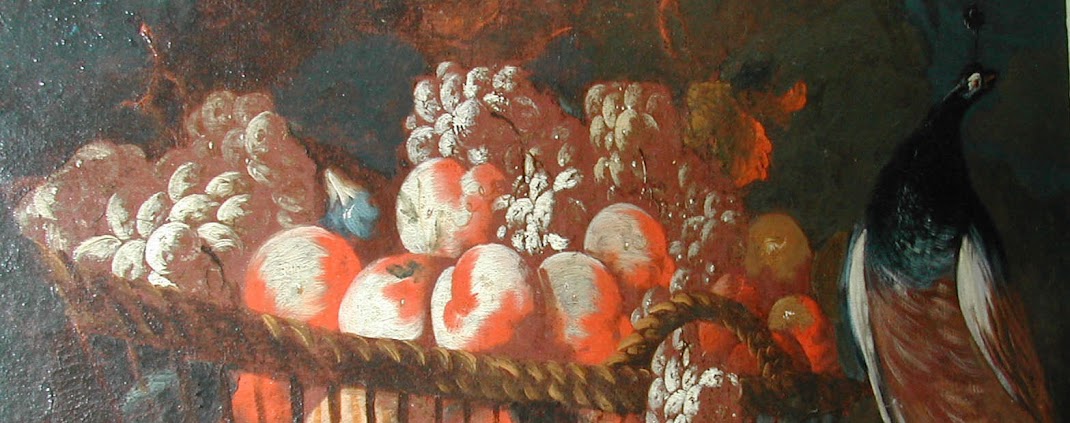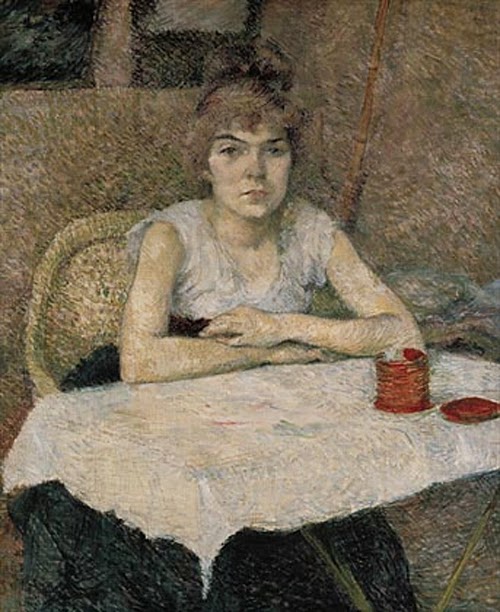My yearly diaries come from the National Gallery, London
2014 is a collection of nineteenth and early twentieth-century paintings.
Every week is provided by a stunning painting,
portraits, landscapes and still-lifes,
produced during the most innovative and exiting periods in the history of art.
Week 41 - Third week of October:
Lord Ribblesdale (detail), 1902
National Gallery, London
by
John Singer Sargent, 1856-1925
"I don't dig beneath the surface for things
that don't appear before my own eyes"
John Singer Sargent
_-_Self-Portrait_1907_b.jpg) Self Portrait, 1906, oil on canvas,
Uffizi Gallery
Self Portrait, 1906, oil on canvas,
Uffizi Gallery, Florence.
John Singer Sargent, the son of an American doctor, was born in Florence
in 1856.
He studied painting in Italy and France and in 1884 caused a
sensation
at the Paris Salon with his painting of Madame Gautreau.
Exhibited as Madame X, people complained that the painting was
provocatively erotic.
The scandal persuaded Sargent to move to England
and over the next few
years established himself as the country's leading portrait painter.
This included portraits of Joseph Chamberlain (1896), Frank Swettenham
(1904) and Henry James (1913).
Sargent made several visits to the USA
where as well as portraits
he worked on a series of decorative paintings
for public buildings
such as the Boston Public Library (1890) and the
Museum of Fine Arts (1916).
(1)
Madame X or Portrait of Madame X
is the informal title of this portrait painting
of a young socialite named
Virginie Amélie Avegno Gautreau, wife of Pierre Gautreau.
The model was an American
expatriate
who married a French banker,
and became notorious in Parisian high
society for her beauty and rumored infidelities.
She wore lavender
powder and prided herself on her appearance.
Madame X was painted not as a commission, but at the request of Sargent.
It is a study in opposition. Sargent shows a woman posing in a black
satin dress with jeweled straps,
a dress that reveals and hides at the
same time.
The portrait is characterized by the pale flesh tone of the
subject contrasted against a dark colored dress and background.
For Sargent, the scandal resulting from the painting's controversial reception at the
Paris Salon of 1884
amounted to the failure of a strategy to build a long-term career as a portrait painter in France,
though it may have helped him establish a successful career in Britain and America.
*
Background:
Renowned for her beauty, Gautreau represented the
parisienne,
a
new type of Frenchwoman recognized for her sophistication.
The
English-language term "professional beauty",
referring to a woman who
uses personal skills to advance to elite status,
was also used to
describe her.
Her unconventional beauty made her an object of fascination for artists;
the American painter
Edward Simmons claimed that he
"could not stop stalking her as one does a deer."
Sargent was also impressed, and anticipated that a portrait of Gautreau
would garner much attention at the upcoming Paris Salon,
and increase
interest in portrait commissions.
He wrote to a friend:
"I have a great desire to paint her portrait and have reason to think
she would allow it and is waiting for someone to propose this homage to
her beauty. If you are 'bien avec elle' and will see her in Paris, you
might tell her I am a man of prodigious talent."
Although she had refused numerous similar requests from artists,
Gautreau accepted Sargent's offer in February 1883.
Sargent was an expatriate like Gautreau, and their collaboration has
been interpreted
as motivated by a shared desire to attain high status
in French society.
A figure study by Sargent in watercolor and graphite, c. 1883
Little progress was made during the winter of 1883,
as Gautreau was
distracted by social engagements,
and was not by nature inclined to the
discipline of sitting for a portrait.
At her suggestion, Sargent
traveled to her estate in
Brittany in June,
where he commenced a series of preparatory works in pencil, watercolors, and oils.
About thirty drawings resulted from these sessions, in which many poses
were attempted.........
......Just as she had been in Paris, in the country Gautreau was bored by
the process of sitting;
here, too, there were social engagements,
as
well as the responsibilities of tending to her four-year-old daughter,
her mother, house guests, and a full domestic staff.
Sargent complained
of "the unpaintable beauty and hopeless laziness of Madame Gautreau......
info source
here
John Singer Sargent in his studio with Portrait of Madame X, c. 1885
*
*
John Singer Sargent, January 12, 1856 – April 14, 1925
considered the "leading portrait painter of his generation" for his evocations of Edwardian era luxury.
During his career, he created roughly 900 oil paintings and more than
2,000 watercolors,
as well as countless sketches and charcoal drawings.
His oeuvre documents worldwide travel, from Venice to the Tyrol, Corfu,
the Middle East, Montana, Maine, and Florida.
His parents were American, but he was trained in Paris prior to moving to London.
Sargent enjoyed international acclaim as a portrait painter,
although
not without controversy and some critical reservation;
an early
submission to the Paris Salon, his "Portrait of Madame X",
was intended to consolidate
his position as a society painter, but it
resulted in scandal instead.
From the beginning his work was
characterized by remarkable technical facility,
particularly in his
ability to draw with a brush, which in later years inspired admiration
as well as criticism for a supposed superficiality.
His commissioned
works were consistent with the grand manner of portraiture,
while his informal studies and landscape paintings displayed a familiarity with Impressionism.
In later life Sargent expressed ambivalence about the restrictions of formal portrait work,
and devoted much of his energy to mural painting and working en plein air.
He lived most of his life in Europe.
*
Sargent's best portraits reveal the individuality and personality of the
sitters;
his most ardent admirers think he is matched in this only by
Velázquez,
who was one of Sargent's great influences.
The Wyndham Sisters -
Lady Elcho, Mrs. Adeane, and Mrs. Tenant
The Misses Vickers, 1884
The Spanish
master's spell is apparent in
Sargent's The Daughters of Edward Darley
Boit, 1882,
a haunting interior which echoes Velázquez' Las Meninas.
The Daughters of Edward Darley Boit', 1882
Museum of Fine Arts, Boston
*
"Venetian wine shop" c. 1898
Private collection
*
*
An Artist in His Studio, 1904
Museum of fine Arts, Boston
*
*
Street in Venice,1882, Oil on panel
National Gallery of Art, Washington, DC

































%2B%2BPortrait%2Bof%2BSuzanne%2BValadon%2B(2).jpg)











_-_Self-Portrait_1907_b.jpg)
%2C_John_Singer_Sargent%2C_1884_(unfree_frame_crop).jpg)




.jpg)


.jpg)





































